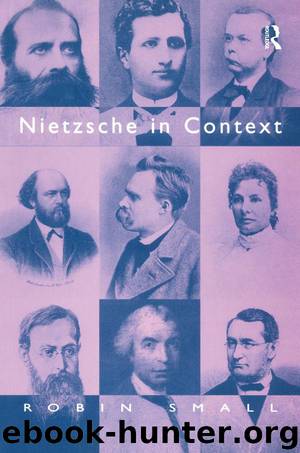Nietzsche in Context by Small Robin

Author:Small, Robin [Small, Robin]
Language: eng
Format: azw3
ISBN: 9781351914567
Publisher: Taylor and Francis
Published: 2017-07-05T04:00:00+00:00
Thomson himself had been more cautious in the formulation of his conclusion. He mentioned only that from a general application of Carnot’s theorem it followed that within a finite period of time, the earth would become unfit for the habitation of human beings ‘as at present constituted’.61 But it was Helmholtz’s version that gained currency. And it was this general conclusion that Nietzsche encountered in his studies of natural science, not the particular calculation derived from Carnot which appears in Thornson’s account.
Nietzsche knew that the development of mechanism had given rise to the conclusion that the laws governing the evolution of the physical world implied a cessation of activity at some future time. This theory had been widely discussed by German writers, and various attempts had been made to offer a solution to the problem. Whether Nietzsche knew why mechanism led to this consequence is another matter. We can only look into his further remarks on the themes of force and finality to provide a clue. Of central importance are the differences between what Nietzsche sees as the mechanistic approach and what he puts forward as his own approach to the philosophy of nature. In the notebook entry that mentions Thomson, Nietzsche goes on to describe the world as consisting of ‘a certain definite number of centres of force’ and argues that these are capable of forming only a calculable number of combinations, so that in an infinite time the same sequence of combinations must occur again and again. This is his doctrine of eternal recurrence, which we will examine in some detail in the following chapters. Nietzsche writes: ‘This conception is not by itself a mechanistic conception; for if it were that, it would not condition an infinite recurrence of identical cases, but a final state.’62 He is aware of how close his own view is to a mechanistic one and is concerned to point out the main differences. In fact, he often presents it as something like an improved version of mechanism, which in its present form has failed to avoid the consequence of a final state.
When Nietzsche says that his own approach is not ‘by itself’ (ohne weiteres) a mechanistic conception, this suggests that the important difference is not mentioned in the text of his description, but lies in the presence or absence of some further element. We saw in Chapter 4 that he had been impressed by Zöllner’s proposal for a conception of space as finite but unbounded. On that interpretation, it is because mechanism makes a certain assumption about the shape of space’ – presumably that it is infinite – that it leads to the prediction of a final state. Nietzsche wrote to Köselitz:
have already told you in conversation my view: that ‘finite’ space – that is, space having a determinate shape – is inevitable in the context of the mechanistic world-view, and that the impossibility of a state of equilibrium seems to me to hang together with the question of how total space is
Download
This site does not store any files on its server. We only index and link to content provided by other sites. Please contact the content providers to delete copyright contents if any and email us, we'll remove relevant links or contents immediately.
The Vikings: Conquering England, France, and Ireland by Wernick Robert(79847)
Ali Pasha, Lion of Ioannina by Eugenia Russell & Eugenia Russell(40109)
The Conquerors (The Winning of America Series Book 3) by Eckert Allan W(37095)
The Vikings: Discoverers of a New World by Wernick Robert(36903)
Cecilia; Or, Memoirs of an Heiress — Volume 1 by Fanny Burney(32396)
Cecilia; Or, Memoirs of an Heiress — Volume 3 by Fanny Burney(31789)
Cecilia; Or, Memoirs of an Heiress — Volume 2 by Fanny Burney(31759)
Empire of the Sikhs by Patwant Singh(22931)
The Secret History by Donna Tartt(18793)
Hans Sturm: A Soldier's Odyssey on the Eastern Front by Gordon Williamson(18448)
Cat's cradle by Kurt Vonnegut(15129)
Pimp by Iceberg Slim(14275)
Sapiens: A Brief History of Humankind by Yuval Noah Harari(14189)
Talking to Strangers by Malcolm Gladwell(13163)
Norse Mythology by Gaiman Neil(13159)
Leonardo da Vinci by Walter Isaacson(13131)
4 3 2 1: A Novel by Paul Auster(12247)
Underground: A Human History of the Worlds Beneath Our Feet by Will Hunt(11992)
The Radium Girls by Kate Moore(11888)
